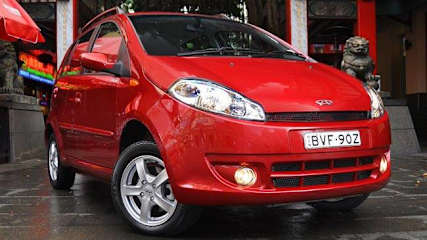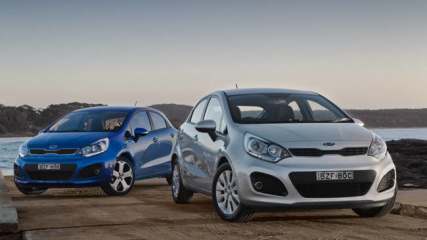2011 Carsguide Car of the Year winners
By Paul Gover · 16 Dec 2011
And it produced a surprise winner for 2011. It's the Kia Rio. The Korean compact claims the crown by just one vote over the impressive Volvo S60, with the funky Ford Focus rounding out the top three at the end of a year that is setting all sorts of records.
More than one million cars will again find new homes in 2011, it's increasingly likely that the Holden Commodore's 15-year reign as Australia's favourite car will end, and new brands from China - Geely and Chery - have taken the count in showrooms to more than 60 individual nameplates.
On the COTY front, the Rio becomes the second baby-class member and only the second Korean car to claim the crown, as well as the first from the junior member of the Hyundai-Kia conglomerate.
The Rio scores its success off the back of impressive design and packaging, tweaking by an Australian suspension expert, topped by smart pricing starting from $16,290.
Surprisingly, it was top choice with six of the 10 COTY judges in 2011, as the Volvo and Ford split the others.
At the end of two intensive and tiring days of back-to-back running, the Rio did best when measured against the COTY judging criteria of value, design, technology and safety.
"It's a nice, light, easy car to drive. It's got a feisty engine and some nice little touches like the hill-start system and an upshift indicator light," says chief judge, Ged Bulmer.
The safety-first Volvo S60 is also a hit with judges, apart from one obvious shortcoming in Australia.
"The only thing I don't like is the spare tyre. It doesn't have one," says Neil Dowling. "For what it is, it drives well. Inside, the design is kinda the anti-Focus."
The baby Ford is a driving favourite but loses out for its ergonomics and a higher price point than the Rio.
"It's good value, has a good sound system, and is good value. But the dash layout is ordinary - it looks like someone threw the buttons at the dash," says Mark Hinchliffe.
The COTY contest in 2011 follows a familiar pattern of recent times, with 10 judges, 10 cars and two days of tough driving on a variety of surfaces to check everything from freeway noise levels and fuel economy to dust sealing and cornering grip. There is also an intensive pre-drive briefing and quality check on all 10 contenders, which range in price from the Nissan Micra at $14,990 as an ST automatic to the heavily-loaded Range Rover Evoque at nearly $100,000.
Action starts at the Ford Proving Group at You Yangs when all the contenders come together for the first time, with the good looking Evoque and the homeground hero - the diesel-powered Ford Territory diesel - sharing the spotlight.
Everyone wants to know how they will compare, which strengths and weaknesses will be revealed, and how the eventual contenders will stack up against the reigning COTY champion, the Volkswagen Polo.
One change for 2011 is an early cull which takes out five hopefuls.
At then end of a rugged first day, with many laps of the right-and-handling course at You Yangs, a gravel-road circuit and road time in and around Geelong, there are a few surprises.
The Evoque is out early because it is poor value, quality and driving failings let the Micra down, while the Volkswagen Scirocco is way too sports focussed - one judge asks for a kidney belt because the ride is almost rock hard - and the Hyundai i40 is nothing special for design or driving. The Territory also goes out because of its basic age, despite the updated front-end styling and diesel for 2011, and shortcomings in a variety of areas.
So day two starts early with five cars - with the Holden Cruze hatch as the only local - and two judges aboard each for a series of real-world road loops and plenty of swapping and changing.
Then it's time for a sit-down, talk-through and the final voting. Each judge lists their cars from top to bottom and the one with the lowest score wins.
The Cruze looks good but has plenty of shortcomings, from lacklustre rear suspension to reflections on the instruments.
"Back-to-back it with the Focus and you have to go with the Ford," says Stuart Martin.
The BMW is a driving favourite, but it has a cramped cabin and falls down on value.
"It's not what you expect for that sort of money. The packaging is compromised," says Neil Dowling.
So the final three emerge, at the end of a tight contest with no truly standout car. The Toyota Camry might have been The One, and Ford also has the four-cylinder Falcon coming soon, but both arrived too late for the COTY cutoff.
Eventually, the Rio emerges as the judges' choice and a surprising favourite despite its compact size and value-first pricing. It's definitely helped by the suspension work by Graeme Gambold, as well as a six-speed gearbox and feisty engine.
"It looks good and it's value for money. All the audio stuff is there. It's got cruise control and a spare," says Karla Pincott. "Is it better than the best cars in the class? Yes."
And there it is, the Carsguide Car of the Year for 2011.
FINISHING ORDER
1. Kia Rio
2. Volvo S60
3. Ford Focus
4. BMW 118
5. Holden Cruze
6. Range Rover Evoque
7. Ford Territory
8. Volkwagen Scirocco
9. Hyundai i40
10. Nissan Micra.















